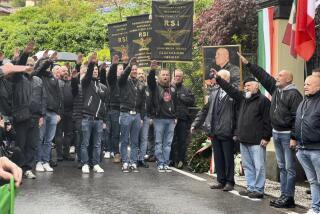Mussolini Hometown Ready to Face World : Tourism: After years off the sightseeing circuit, visitors are solicited. Town fathers plan to restore the dictator’s residences.
- Share via
PREDAPPIO, Italy — Benito Mussolini’s hometown spent decades trying to hide the fact. It wasn’t easy, because the dictator filled Predappio with those brooding stone buildings so dear to his fascist heart.
No tour bus was allowed into this village in the rolling vineyard country of north-central Italy. Shops were forbidden to sell postcards depicting Il Duce.
Communists and Socialists governed Predappio, each trying to be more disdainful of the famous native son than its predecessor.
Then, a funny thing happened on the way to the 1990s.
“Politics have changed,” said Mayor Ivo Marcelli of the Democratic Party of the Left, which was the Communist Party until 1991. “You can’t maintain that sense of hatred forever.”
Ergo, village fathers are planning a major restoration of the town Mussolini made a monument to his 21 years in power. The dictator has become a resource, along with the region’s famed egg pasta and Sangiovese grapes.
Some Italians describe Predappio’s case as the story, in microcosm, of how all Italy is re-evaluating its fascist past.
“It’s not news any more; it’s history,” said Antonio Spinosa, author of several books on the fascist period, 1922 through 1943. “No one is afraid of Mussolini any more.”
Predappio plans to restore Mussolini’s childhood home, his summer residence and a former Fascist Party headquarters. They are to become museums and centers for studying dictatorship.
The project has remarkably broad support. Six deputies, whose politics range from neo-fascist to leftist, asked Parliament for $10 million to help pay for it. Restoration work has begun on the family home, financed by a grant from the regional government.
“We’re not trying to hark back to the past,” the 40-year-old mayor said. “We just want to conserve and utilize buildings that are there, and should be used intelligently.”
Marcelli concedes that the project would not have been possible a few years ago. In the 1970s, when terrorism from both the right and left plagued Italy, this town of 6,000 made headlines because of fierce clashes between supporters and opponents of fascism.
Some say the end of the Cold War helped bring the change. Giorgio Bocca, a columnist and author, noted that the postwar communist grip on Italian culture has faded like the party.
“There was a demonization of fascism, of all that was fascist,” said Bocca, an anti-fascist. He added, referring to Mussolini: “There is not exactly a rethinking, but a more fair evaluation of the person.”
Tourism to Predappio has increased dramatically, whatever the reason. Last year, about 100,000 people visited Mussolini’s stone tomb, which is topped by a huge bust of Il Duce.
Most were Italians, but thousands of Germans, Austrians, Dutch and others visited while vacationing on the nearby Adriatic coast.
What irritates the mayor is that most of the tourists stopped in the town only briefly.
The restoration project seems to be a popular idea. Merchants are selling Mussolini ashtrays, key chains with tiny jackboots and other souvenirs.
“Italians are talking about Mussolini,” said jeweler Giuseppe Menghi, 65, displaying an array of Mussolini watches and necklaces. “They’re tired of these ignorant politicians of today, who only care about their positions and their wallets.”
Marcelli acknowledged that the restoration may be criticized by people who fear nostalgia for fascism, but he promised it will not glorify the dictator.
Attacks on immigrants are prompting concern in Italy about a resurgence of fascism.
More to Read
Sign up for The Wild
We’ll help you find the best places to hike, bike and run, as well as the perfect silent spots for meditation and yoga.
You may occasionally receive promotional content from the Los Angeles Times.






